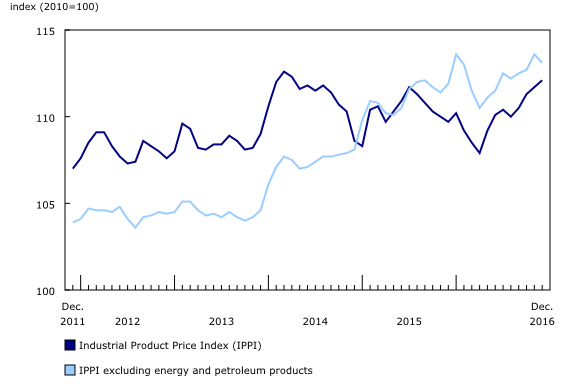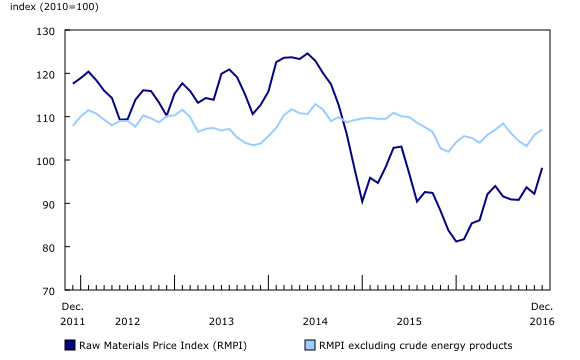Industrial product and raw materials price indexes, December 2016
Archived Content
Information identified as archived is provided for reference, research or recordkeeping purposes. It is not subject to the Government of Canada Web Standards and has not been altered or updated since it was archived. Please "contact us" to request a format other than those available.
Released: 2017-01-31
The Industrial Product Price Index rose 0.4% in December, led mainly by higher prices for energy and petroleum products. The Raw Materials Price Index increased 6.5%, mainly due to higher prices for crude energy products.
Industrial Product Price Index, monthly change
The IPPI rose 0.4% in December, matching the gain in November. Of the 21 major commodity groups, 7 were up, 8 were down and 6 were unchanged.
The growth of the IPPI was primarily driven by higher prices for energy and petroleum products (+5.5%), which posted their largest gain since May 2016 when prices rose 6.6%. The increase in this commodity group was mainly attributable to motor gasoline (+7.1%), light fuel oils (+6.7%) and diesel fuel (+5.3%). The IPPI excluding energy and petroleum products declined 0.4% in December.
Chemicals and chemical products (+0.4%) also contributed to the increase in the IPPI, but to a lesser extent. Petrochemical prices (+3.9%), particularly prices for aromatic hydrocarbon gases (+9.6%), were the main contributor to the increase in chemicals and chemical products, while lower prices for plastic resins (-1.6%) moderated the gain in this group.
Lower prices for meat, fish and dairy products (-1.8%) moderated the advance in the IPPI, mainly due to lower prices for fresh and frozen pork (-6.7%) and fresh and frozen beef and veal (-3.2%). This was the third consecutive monthly decline for this commodity group.
A decrease in prices for motorized and recreational vehicles (-0.7%) also moderated the growth of the IPPI in December. The main reason for the decline in this commodity group was lower prices for passenger cars and light trucks (-0.8%) and, to a lesser extent, motor vehicle engines and motor vehicle parts (-0.4%) as well as aircraft (-0.7%). Lower prices of motorized and recreational vehicles were closely linked to the gain in the Canadian dollar relative to the US dollar.
Primary non-ferrous metal product (-1.3%) prices also declined in December, following a 2.4% increase the previous month. The decline was largely attributable to lower prices for unwrought precious metals and precious metal alloys (-4.0%), particularly unwrought gold and gold alloys (-7.1%). Higher prices for unwrought copper and copper alloys (+3.3%) and basic and semi-finished products of aluminum and aluminum alloys (+2.0%) moderated the decline in this commodity group.
Some IPPI prices are reported in US dollars and are converted to Canadian dollars using the average monthly exchange rate. As a result, any change in the value of the Canadian dollar relative to the US dollar will affect the level of the index. From November to December, the Canadian dollar rose 0.8% relative to the US dollar. If the exchange rate had remained constant, the IPPI would have increased 0.5% instead of 0.4%.
Industrial Product Price Index, 12-month change
The IPPI rose 2.2% during the 12-month period ending in December following a 1.5% increase in November.
Compared with December 2015, the advance of the IPPI was largely attributable to higher prices for energy and petroleum products (+10.5%), which posted their strongest year-over-year growth since February 2012. The increase in this commodity group was mainly driven by light fuel oils (+24.9%), motor gasoline (+8.1%) and, to a lesser extent, diesel fuel (+12.7%) and heavy fuel oils (+28.8%). On a year-over-year basis, the IPPI excluding energy and petroleum products rose 1.1%.
Primary non-ferrous metal products (+9.3%) also contributed significantly to the year-over-year increase in the IPPI. Unwrought precious metals and precious metal alloys (+9.0%), other unwrought non-ferrous metals and non-ferrous metal alloys (+28.0%), and unwrought copper and copper alloys (+18.5%) were the main source of the year-over-year increase in primary non-ferrous metal products.
On a year-over-year basis, the advance of the IPPI was largely offset by lower prices for motorized and recreational vehicles (-1.7%). The main source of the decline in this group was lower prices for passenger cars and light trucks (-2.1%) and, to a lesser extent, motor vehicle engines and motor vehicle parts (-1.8%) and aircraft (-1.8%).
The decrease in prices for meat, fish and dairy products (-2.7%), which was mainly attributable to lower prices for fresh and frozen beef and veal (-14.1%), also slowed the growth of the IPPI compared with December 2015.
Raw Materials Price Index, monthly change
The RMPI rose 6.5% in December following a 1.6% decrease in November. Of the six major commodity groups, five were up and one was down.
The growth of the RMPI was primarily driven by higher prices for crude energy products (+14.2%), particularly conventional crude oil (+15.0%), which posted its largest gain since May 2016. The RMPI excluding crude energy products rose 1.1%.
Prices for animals and animal products (+3.2%) had a modest contribution to the growth of the RMPI. The gain in this commodity group was primarily driven by higher prices for live animals (+5.6%), particularly hogs (+11.2%) as well as cattle and calves (+4.5%).
The logs, pulpwood, natural rubber and other forestry products group (+2.3%), particularly natural rubber (+16.7%), also exerted upward pressure on the RMPI.
Raw Materials Price Index, 12-month change
The RMPI rose 17.2% during the 12-month period ending in December, following a 4.4% gain in November.
The increase in the RMPI in December was largely attributable to higher prices for crude energy products (+38.2%), particularly conventional crude oil (+40.1%). The RMPI excluding crude energy products rose 5.0%.
Metal ores, concentrates and scrap were also up from December 2015, with prices rising 17.9% following a 16.6% increase the previous month.
The year-over-year gain in the RMPI was moderated by lower prices for animals and animal products (-3.7%), which have been declining since July 2015. The main source of the decline in this group was lower prices for live animals (-9.0%), particularly cattle and calves (-12.3%) and hogs (-8.3%).
The evolution of industrial product and raw materials prices in Canada
As 2017 marks the 150th anniversary of Confederation, we take a look at the history of industrial product and raw materials prices in Canada.
In the early 1900s, employees of the Dominion Bureau of Statistics compiled price data back to 1867 using newspapers and trade journals. Prices were collected for 89 commodities, mainly in the vegetable and animal product groups.
In the years following Confederation, the commodity with the greatest growth was wood, wood products and paper, which rose 166.2% from 1867 to 1910. All metal commodity groups declined over the same period, particularly iron and its products (-43.1%).
Note to readers
The Industrial Product Price Index (IPPI) and Raw Materials Price Index (RMPI) are available at the Canada level only. Selected commodity groups within the IPPI are also available by region.
With each release, data for the previous six months may have been revised. The indexes are not seasonally adjusted.
The Industrial Product Price Index reflects the prices that producers in Canada receive as the goods leave the plant gate. It does not reflect what the consumer pays. Unlike the Consumer Price Index, the IPPI excludes indirect taxes and all the costs that occur between the time a good leaves the plant and the time the final user takes possession of it, including transportation, wholesale and retail costs.
Canadian producers export many goods. They often indicate their prices in foreign currencies, especially in US dollars, which are then converted into Canadian dollars. In particular, this is the case for motor vehicles, pulp, paper and wood products. Therefore, a rise or fall in the value of the Canadian dollar against its US counterpart affects the IPPI. However, the conversion into Canadian dollars only reflects how respondents provide their prices. This is not a measure that takes the full effect of exchange rates into account.
The conversion of prices received in US dollars is based on the average monthly exchange rate (noon spot rate) established by the Bank of Canada and available in CANSIM table 176-0064 (series v37426). Monthly and annual variations in the exchange rate, as described in the release, are calculated according to the indirect quotation of the exchange rate (for example, CAN$1 = US$X).
The Raw Materials Price Index reflects the prices paid by Canadian manufacturers for key raw materials. Many of those prices are set on the world market. However, as few prices are denominated in foreign currencies, their conversion into Canadian dollars has only a minor effect on the calculation of the RMPI.
Infographic: Producer Price Indexes at a Glance
The infographic "Producer Price Indexes at a Glance," which is part of Statistics Canada — Infographics (11-627-M), demonstrates how producer price indexes for goods and services are calculated and why they are important for the Canadian economy.
Real-time CANSIM tables
Real-time CANSIM table 329-8074 will be updated on February 7. For more information, consult the document Real-time CANSIM tables.
Next release
The industrial product and raw materials price indexes for January will be released on February 28.
Contact information
For more information, or to enquire about the concepts, methods or data quality of this release, contact us (toll-free 1-800-263-1136; 514-283-8300; STATCAN.infostats-infostats.STATCAN@canada.ca) or Media Relations (613-951-4636; STATCAN.mediahotline-ligneinfomedias.STATCAN@canada.ca).
- Date modified:





